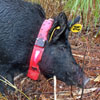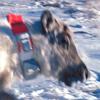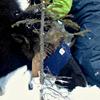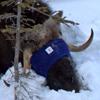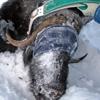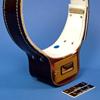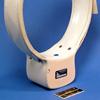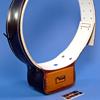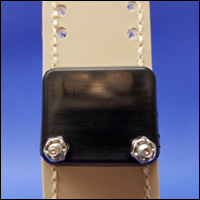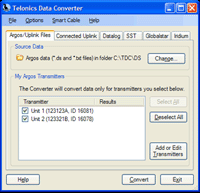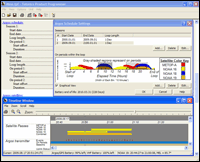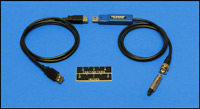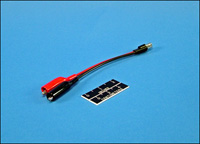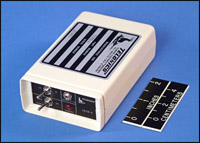GPS/Argos Terrestrial Systems
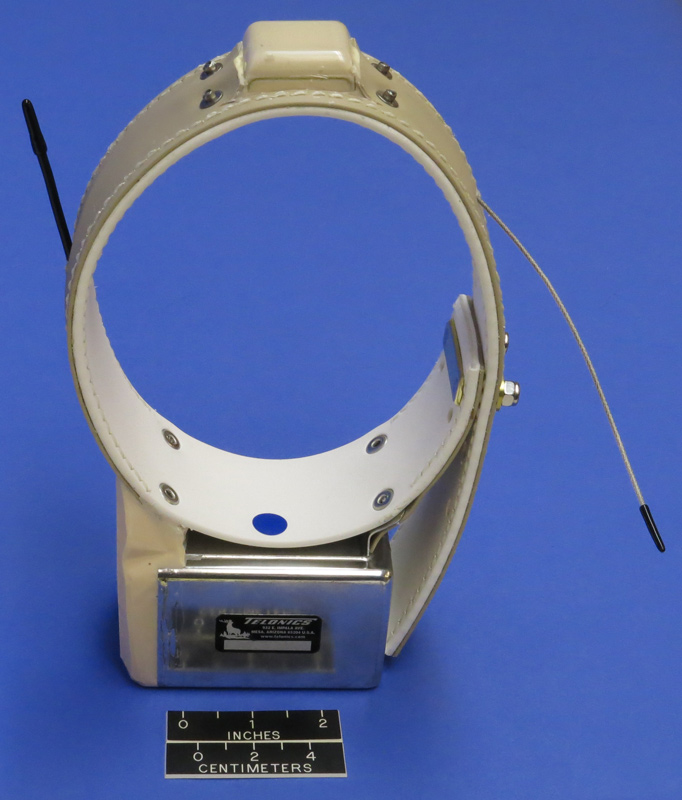
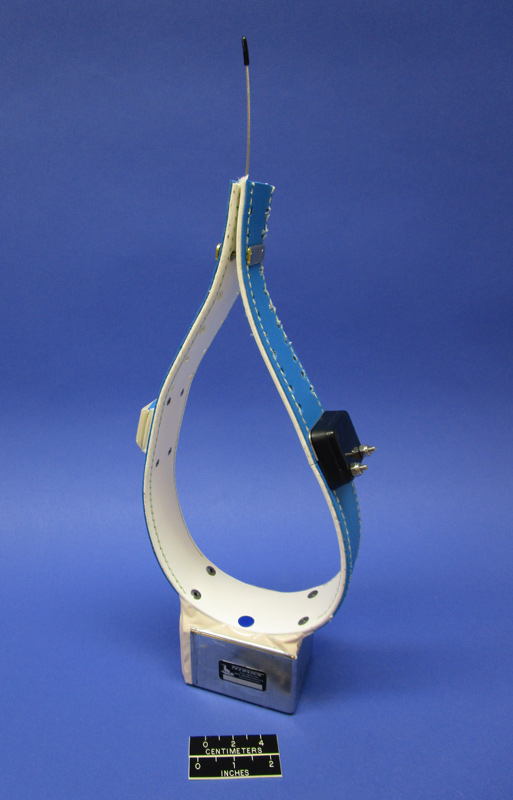
TGW-4680-3 GPS/Argos collars for caribou, conventional shape and teardrop
Models
| Model |
Dimensions L x W x H (in, cm) |
Canister Weight (g) |
Estimated weight w/ collar (g) |
| TGW-4583-3 |
2.9 x 2.3 x 2.0
7.4 x 5.8 x 5.1 |
340 |
700-1100 |
| TGW-4583H-3 |
2.9 x 2.3 x 2.0
7.4 x 5.8 x 5.1 |
340 |
700-1100 |
| TGW-4680-3 |
3.25 x 2.75 x 2.25
8.3 x 7.0 x 5.7 |
625 |
1100-1200 |
| TGW-4680H-3 |
3.25 x 2.75 x 2.25
8.3 x 7.0 x 5.7 |
625 |
1100-1200 |
| TGW-4689H-3 |
3.25 x 2.75 x 2.25
8.3 x 7.0 x 5.7 |
625 |
1250-1400 |
"H" models have 800 mW power output, others are 500 mW standard output.
Examples of Operational Life
| Model |
GPS schedule |
GPS/Argos battery life (years) |
| TGW-4583-3 |
4 GPS/day |
1.7 - 2.1 |
| 8 GPS/day |
1.4 - 1.7 |
| 24/day |
1.0 - 1.1 |
| TGW-4583H-3 |
4 GPS/day |
1.1 - 1.4 |
| 8 GPS/day |
1.0 - 1.2 |
| 24/day |
0.7 - 0.8 |
| TGW-4680-3 |
4 GPS/day |
3.0 - 3.6 |
| 8 GPS/day |
2.6 - 3.1 |
| 24/day |
1.7 - 2.0 |
TGW-4680H-3
or TGW-4689-3 |
4 GPS/day |
1.8 - 2.3 |
| 8 GPS/day |
1.7 - 2.1 |
| 24/day |
1.2 - 1.5 |
The GPS/Argos battery life estimates above are calculated using Telonics Product Programmer (TPP), and assume temperatures of 0°C, average time to GPS fix of 75 seconds, Argos on 4 hours every 2 days, 90 second Argos repetition period, prediction of satellite overpasses on the unit, and a location near 65° North, 143° West. VHF pulse rates and schedules are typically adjusted to match or exceed the estimated GPS/Argos battery life. These are examples only, with many other options possible. Please consult with Telonics for assistance determining what would work best for your application.
Key Features
- These collars collect GPS positions and optionally other sensor data and transmit that information through the Argos system. Users must apply to utilize the Argos system, and will be assigned ID codes and repetition periods.
- Argos satellite are in near polar orbits, and have the most overpasses and cumulative time visible to the Argos PTT on the animal near the poles, and the least number of overpasses and cumulative time visible near the equator.
- TGW-4*8*H-3 models have 800 mW power output, others are 500 mW standard output.
- The TGW-4689H-3 model includes a salt-water-switch, as sometimes used on polar bears.
- Data retrieved through Argos, or downloaded from a unit in hand, are processed using Telonics Data Converter (TDC). TDC is used to convert raw data from Telonics transmitters into data reports and to display locations on Google Earth and Google Maps. You can review, save, and edit TDC reports in Microsoft Excel or other spreadsheet programs.
- GPS, Argos, and VHF scheduling can be programmed as a continuous intervals, or to change over time (e.g. seasonal changes where monitoring might be more or less intensive at certain times). These units have two battery packs, one for GPS/Argos and the other for VHF.
- Each Argos transmission can hold ~6 GPS positions, but because Argos satellites are only intermittently overhead, data is repeated multiple times to have a good probability of reception at the satellites.
- Transmissions can contain a mortality flag (which relates to whether there has been movement detected by an accelerometer within a user-defined period) and a low-voltage flag (which indicates the battery may die soon).
- All positions determined and any additional sensor data collected (if applicable) is stored-on-board the unit, thus if the tag recovered, stored data can supplement what was transmitted.
- A real-time clock and calendar controls all timing functions and is re-synchronized with GPS time to assure high accuracy timing. All timing is programmed using Coordinated Universal Time (UTC).
- Users can program or reprogram the units through use of Telonics Product Programmer (TPP). TPP can be used to obtain estimates of battery life under various possible programming scenarios prior to deployment.
- The units also include VHF capability. If VHF is activated, the VHF transmitter shares the same antenna as used by the Argos transmitter.
- When turned off using a magnetic switch, these units consume less than 10 µA; this allows storage for extended periods with minimal impact on operational life.
- Units can be refurbished to their original condition at Telonics.
Specifications: Electronic and Packaging - GPS/Argos - Show
General System Specifications
| Timing Accuracy | Timing is synchronized to GPS time when available. If the GPS time is not then internal timing accuracy is:
6 min/year at 25° C
30 min/yr -20 to +40° C
47 min/yr -40 to +70° C |
|---|
| Available Sensors | Mortality, Activity, Temperature, Low Voltage |
|---|
| Memory Capacity | Capable of storing 500K fixes in nonvolatile flash memory in association with other sensor data. |
|---|
| Argos Transmissions | System can be operated in a mode where unit transmits only during satellite overpasses based on the GPS location and the orbital parameters installed prior to deployment. (GPS-Argos systems only) |
|---|
GPS Receiver Specifications
| Standby Current | 0µA |
|---|
| Performance | 12 channels
-159 dBm tracking sensitivity
-145 dBm acquisition sensitivity |
|---|
| Datum | WGS-84 |
|---|
| Time to First Fix (TTFF) | 40sec typical (with clear view of sky) |
|---|
Argos Certified Transmitter Specifications: (GPS-Argos Configuration only)
| RF Output Impedance | 50 Ohms |
|---|
| Operating Frequency | ARGOS Frequencies
401.6300 MHz to 401.6800MHz in 1 kHz Steps
Brazilian SCD-1, Channels C1 to C9
401.6180 MHz to 401.6220MHz in 500 Hz Steps |
|---|
| Frequency Stability | +/- 0.5 ppm maximum from -30° to +70° C
+/- 2.0 ppm maximum from -40° to -30° C |
|---|
| Initial Frequency Error | +/- 0.5 ppm maximum at +23°, +/- 2° C |
|---|
| Aging | +/- 2.0 ppm maximum after 1 year |
|---|
| RF Power Out | Standard Power Version:
400 mW (+26 dBm) or 500mW (+27 dBm) nominal into 50 Ω
(User selectable using TPP programming software)
High Power Version (H):
800 mW (29 dBm) +/-1db nominal into 50 Ω
(User selectable using TPP programming software)
Note 1: Transmit current will increase by approximately 10% from the +25° C measurement. Conversely, at -40° C it will decrease by approximately 10% from the +25° C measurement.
Note 2: Transmit current and RF power out are sensitive to VSWR. Both can be degraded significantly if the antenna or antenna coax are of poor quality or not correctly tuned and matched to the ARGOS/Brazilian frequency band 50 ohm RF output impedance.
|
|---|
| Spurs and Harmonics | <-40 dBc minimum, -60 dBc typical (Coherent Spurious)
<-50 dBc minimum, -60 dBc typical (Non-coherent spurious) |
|---|
MK10 µGPSI-022 VHF Transmitter Specifications
| Available Frequency Options | Option 705 140-154 MHz;
Option 707 144-158 MHz;
Option 715 154-171 MHz;
Option 720 160-177 MHz;
Option 740 174-192 MHz;
Option 750 191-210 MHz;
Option 760 210-237 MHz
The MK10 frequency can be programmed in 100Hz steps within a given frequency range. |
|---|
| Frequency Stability | Better than ±3 ppm at room temperature;
±5 ppm total tolerance over full temperature range |
|---|
| Operating Temperature | -40° to + 70° C (end user must ensure that the power supply/battery can provide the required peak current and voltage) |
|---|
| Pulse Width | Programmable (10 to 250 msec) |
|---|
| Pulse Period | Programmable (560 to 5000 msec)
3 separate pulse period values selectable:
Period 1 (indicates last GPS fix successful)
Period 2 (indicates last GPS fix unsuccessful)
Mortality period (if no motion for selected time) |
|---|
| Available Sensors | Mortality Sensor (parameters are user programmable) |
|---|
| Transmitter Timing | Programmable seasons and duty cycles |
|---|
| Power Output | Programmable Low/Medium/High power.
Effective Isotropic Radiated Power (EIRP) varies, depending on packaging, antenna configuration, and immediate environmental conditions.
* California Users: This transmitter meets the California requirement of EIRP <0.009 W for all configurations. |
|---|
| Emission Designator | 2k00P0N |
|---|
| Harmonic Suppression | Better than 30 dB (>40 dB typical) |
|---|
| Spurious Emissions | <-35 dBc at 10 kHz offset from carrier |
|---|
| Power Supply | 2.5-5.5 Vdc |
|---|
| Peak Transmit Current | 19 mA/25 mA/34 mA (Low/Med/Hi) |
|---|
| Quiescent Current | <10 µA between VHF pulses |
|---|
| Frequency | Aging: <1 ppm/yr
Shock: <1 ppm 3000 g x 0.3 ms x ½ sine x 3 dir |
|---|
| VSWR | RF output stable to 10:1 VSWR, all phases
Radiated harmonic levels are degraded with poor load VSWR.
Spurious emission specification maintained for >10:1 VSWR |
|---|
| Programming | Transmitter parameters programmable via antenna "1-pin" interface and Telonics TPP PC software. |
|---|
Packaging/Housing Specifications
| Hermetic Metal Canisters | Electronics are sealed in hermetic metal canisters containing the electronics, batteries, and all interconnects. Glass to metal feed-thru technology is used to exit antennas and power. This packing is hermetic and can be tested utilizing a helium leak bomb test for hermeticity to assure < 1 part in 106 atmospheric CC per second. |
|---|
GPS Antenna Specifications
| Collared Mounted GPS Antenna | In collar mounted wildlife configurations, the GPS antenna is designed to be mounted on the dorsal surface of the neck. The GPS antenna is installed in a high impact nonconductive plastic housing. The form of the housing presents sloping sides so that it will be impervious to chewing and gnawing as is possible. A highly armored antenna cable connects the GPS antenna to the instrument package. |
|---|
Collar Specifications
| Collared Designs | Collar designs are species specific. |
|---|
Photo Gallery
Manual
Related Products
Legacy Products
This information on discontinued products is provided for individuals who are still using these older systems. Product descriptions may be time sensitive or even outdated. Please contact Telonics if you have questions.
The following subsystems are obsolete and are not available to be refurbished:
Lithium Battery Shipping Regulations
Telonics Inc. ships all systems containing lithium batteries in accordance with the US Department of Transportation rules for hazardous materials set forth in 49CFR and the IATA Dangerous Goods Regulations.
Shipping dangerous goods can be complicated and confusing, consult a dangerous goods specialist if needed. The general requirements for shipping lithium batteries according to 49CFR are located in Part 173, Subpart 173.185 in the link below.
http://www.ecfr.gov/cgi-bin/text-idx?SID=e8334217c2c8d081457a5156872ad037&tpl=/ecfrbrowse/Title49/49cfrv2_02.tpl#0
Service Commitment
Since 1970, Telonics has built a reputation based on product quality, product support, service, and customer satisfaction. Telonics strives to produce the highest quality products, and to support those products accordingly.
Because of extreme conditions and the unpredictable nature associated with most telemetry applications, problems occasionally arise. Most problems can be resolved quickly. In all cases, we hope to be able to work in partnership with users to resolve problems to the user's satisfaction and to uphold our demonstrated commitment to excellence. If problems should arise, all products must be returned to our factory for failure analysis.
Warranty: GEN 4 GPS Systems - Show
Telonics warrants its GPS products to be free from defects in material and workmanship for a period of one year from the date acquired. Telonics does not warrant batteries.
Telonics designs and manufactures systems for a variety of applications using several satellite systems (GPS, Argos, Iridium, and Globalstar). At the time of manufacturing, Telonics equipment is tested to verify compatibility with the applicable satellite system(s). Telonics does not warranty equipment against changes in satellite system specifications or satellite operation after the date your equipment was manufactured. Unforeseeable or unplanned system changes would include, but are not limited to, elevated ambient noise levels in the radio frequency bands used for satellite communications, elimination of service in a region of the world, data outages due to technical problems within the satellite system network, or reductions in data transfer capability due to alterations in the constellation as a result of premature space vehicle failures or failure to replace space vehicles in a timely manner.
If a defect occurs, return the equipment to us within the proper time frame at the following address: TELONICS, 932 E. IMPALA AVENUE, MESA AZ USA 85204-6699. The customer shall arrange for and pay all shipping, insurance and related charges incurred in the shipment to and from Telonics under this warranty. Damage to any equipment resulting from misuse, accidents, unauthorized service, extreme conditions, or other causes, is excluded from this warranty. Telonics does not assume responsibility for loss or damage to equipment during shipment. Telonics does not assume responsibility for delays resulting from shipment on commercial or private carriers. We insure all equipment shipped from our facility and suggest that shipments to Telonics also be insured.
Upon the timely return to our facility, if defective, the product will be replaced or repaired at our discretion at no cost to the customer. This remedy is the exclusive remedy. This product is supplied without any further warranties or conditions, expressed or implied, including warranties of merchantability, quality or fitness for particular reason or those arising by laws, statutes or trade usage or course of dealing.
The entire risk, as to the results and performance of the product, is assumed by the customer. Neither Telonics, nor its suppliers, shall have any liability to the customer or any other person or entity for any indirect, incidental, special, or consequential damage whatsoever, regardless whether Telonics has been told of the possibility of such damages or that such damages might be foreseeable. Telonics has no responsibility or liability for the claims of any third party. The maximum aggregate to the customer, of Telonics and its suppliers, shall not exceed the amount paid by the customer for the product.





